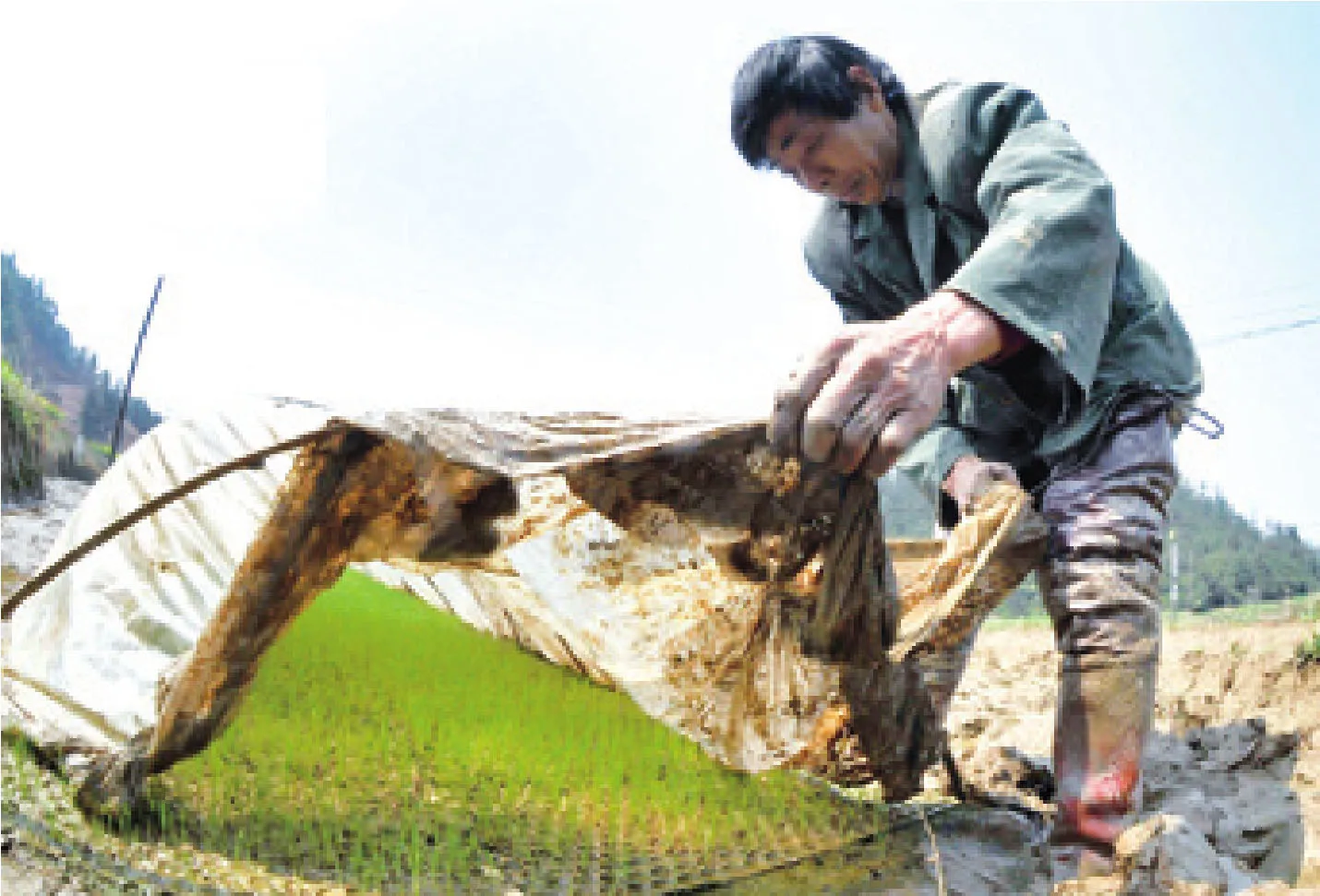The Crisis of Tainted Rice
2013-12-07ByLanXinzhen
By Lan Xinzhen
Soil pollution is impacting one of China’s long-cherished staples.What’s to be done?
Central China’s Hunan Province is one of the country’s biggest rice producers.Because Yuan Longping, China’s “father of hybrid rice,” has his research base in Hunan,the province is highly renowned in the country’s grain market. But, the granary has recently fallen into crisis because of a tainted rice scandal.
According to a February 27 report in Nanfang Daily, in 2009 a bulk of rice containing excessive heavy metal cadmium was sent to Guangdong Province. The news immediately caused a great uproar. Provincial government departments held a meeting on the same day to find a way to guarantee grain safety in the market.
The Guangdong Provincial Government said in a release that in 2009 Shenzhen Cereals Group, a state-owned enterprise for grain reserves and a major rice supplier in Guangdong,purchased about 10,000 tons of rice from Hunan. An inspection by Shenzhen’s quality supervision authority found the rice substandard,containing excessive cadmium.
If just one batch of rice is found to contain excessive cadmium, it might not arouse public panic. But further investigations by government departments and media found that Shenzhen Cereals Group had even tested and found excessive cadmium from rice it purchased from Hunan seven years ago.
Other media reports say that the Agriculture Department of Hunan Province disclosed at a 2012 meeting that heavy metal pollution—including high levels of cadmium, arsenic,copper, zinc and lead—was on the rise in agricultural areas. Absorbed via the roots, pollutants accumulate in crops. In recent years, more and more farm products exported from Hunan have been rejected by importing nations for their high metal levels. Chen Jian, Sales Manager at Changsha Depot of China Grain Reserves Corp.,says most rice produced in Hunan contains excessive cadmium.
Rice is largely consumed as a staple food in China, but it’s also a crop more prone to absorbing excessive heavy metals than other crops like corn and wheat. Experts say more attention is needed by the government to ensure the safety of rice cultivation.
A serious pollutant
Cadmium is a highly toxic heavy metal used in paints and batteries. A small dose of cadmium is harmful to one’s health and can even cause cancer. It can accumulate in the human body for 10-30 years, causing pathological changes in organs such as the kidneys and bones, or even damage the health of the next generation.Countries including China have listed cadmium as a primary metal to watch out for in grain production. According to the Chinese standard, the content of cadmium must not be higher than 0.0013 milligrams per kg of rice.
Xu Xudong, Deputy Director of the Institute of Hydrobiology at the Chinese Academy of Sciences, says rice with excessive cadmium indicates that soil pollution in China has affected grain quality and safety.
“We have been concerned that accelerated urbanization will increase the demand for land, hence reducing the amount of cultivated land below the warning line of 120 million hectares. But now,we should also worry about the damage of heavy metal pollution on cultivated land,” Xu said.
How much land in China has been polluted? There is no exact figure. The Ministry of Environmental Protection and the Ministry of Land and Resources conducted in 2010 a joint survey on the country’s soil pollution, which covered 4.5 million square km of land in the industrialized regions of the Yangtze River Delta,Pearl River Delta, Bohai Economic Rim and the old industrial base in northeast China. The results have not yet been released.
On October 25, 2010 Zhou Shengxian,Minister of Environmental Protection, delivered a report to the Standing Committee of the 11th National People’s Congress, which found the quality of China’s land environment to be poor. In China,10 million hectares of cultivated land has been polluted, accounting for 8.3 percent of the 120 million hectares of land. This is the most authoritative figure till now on soil pollution.
prevention is key
“Only with prevention can we avoid cadmium poisoning,” Xu said, adding that he’s most concerned about whether the polluted land has been too seriously damaged for future cultivation.
In 1955-68, many people in Japan’s Toyama Prefecture suffered from excessive quantities of cadmium found in rice and water sources. A total of 207 people died as a result. After strict measures to tackle pollution, rice produced in Toyama has been tested cadmium-free.
The Toyama lesson serves as a good warning to regions in China with excessive soil pollution, say experts. “In order to develop local economies, many grain producing areas are introducing industries likely to bring heavy metal pollution. Without controlling measures by the government, there could be immeasurable disaster,” said Xu.
He suggests the government formulate regulations to prohibit industries and enterprises likely to bring heavy metal pollution from entering major grain production areas, and those already set up should be moved out as soon as possible.
The country should no longer evaluate the performance of local officials based on industrial development but on grain production and food safety, Xu adds.
The Chinese Government is aware of the need to control soil pollution. In March 2012,the Ministry of Agriculture (MOA) and the Ministry of Finance (MOF) jointly released a plan for preventing and controlling heavy metal pollution in agricultural regions. The MOF also allocated 827 million yuan ($131.9 million) to the MOA to conduct a survey in the next five years on soil pollution. The MOA has gathered a group of experts to offer technological assistance in controlling soil pollution.

HARD AT WORK: A farmer in Wangcheng County,Hunan Province, covers paddy seedlings
The tainted rice scandal has forced local governments to accelerate the implementation of the MOA and MOF scheme. Some pilot projects have started in Hunan to recover heavily polluted land.
Rice market affected
Although Hunan is currently investigating its own problems with tainted rice, results have yet to be publicized, forcing local farmers and grain companies to consider halting rice production altogether.
The scandal has even affected some listed companies too. Hunan Jinjian Cereals Industry Co. Ltd., listed on the A-share market, saw its stock price drop since March. Although rice prices are stable, there seems to be no motivation for stock prices to rise.
Guangzhou Zhujiang Brewery Co. Ltd., also listed on the A-share market, suffered the same price decline as Jinjian for purchasing a large amount of rice from Hunan.
Every year Hunan produces 13 percent of China’s rice output. After ensuring supplies for the locals, the province sells its rice to south China markets including Guangdong Province,Guangxi Zhuang Autonomous Region and Fujian Province. As more tainted rice was found,sales to the south have slowed, causing many rice processing factories in Hunan to shut down.
The prefecture-level city of Yiyang in Hunan is the province’s biggest rice producer with more than 200 rice processing factories and an annual output of 2 million tons. Of the total,70-80 percent is sold to Guangdong and Fujian.Yiyang was once full of trucks transporting rice to the south, but journalists visiting the region in mid March have seen fewer trucks and more closed factories.
As one of China’s biggest rice producers, if Hunan produces less rice, tremors will be felt throughout the entire rice market. Southern regions would have to purchase rice from the country’s northeast or import rice from countries like Thailand at higher prices so as to satisfy market demand. ■
